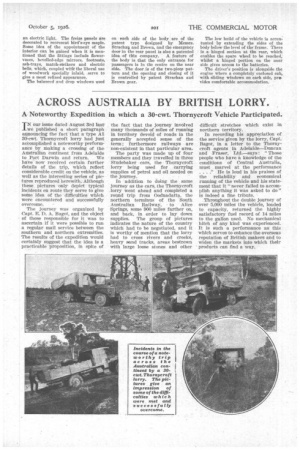A SUMPTUOUS PUBLIC-SERVICE BUS.
Page 62

Page 63

If you've noticed an error in this article please click here to report it so we can fix it.
Brief Details of a Well-appointed Vehicle in which Many Modern Refinements are Incorporated.
IN these days of high-class travel by road one is, perhaps, accustomed to take for granted many of thOse little refinements in equipment which make for improved appearance or increased riding comfort, and it could be said with considerable truth that many passengers fail to observe the untiring efforts of many bus and coach owners to meet the different requirements of the travelling public.
We think, however, that even the most fastidious traveller would freely admit that in the design of the two new saloon buses of which the Sheppey Motor Transport Co. have taken delivery no effort has been spared in an endeavour to embody a galaxy of fittings and equipment not usually found on vehicles used for passenger service. We reprodue herewith illustrations showing offside and near-side views of the bus, as well as one of the interior looking towards the rear ; the last-named gives some idea of the pleasing character of the saloon
The chassis which is used for this vehicle is the E-type produced by Dennis Bros., Ltd., of Guildford, and few chassis lend themselves more readily to the mounting of handsome ooachwork, for the low load-line of '2 ft. enables the overall height to be kept down to a minimum, and this, in turn, results in wellbalanced proportions being maintained throughout the complete vehicle.
Messrs. Strachan and Brown, Wales Farm Road, North Acton, London, W.3, who have had much experience in the manufacture of high-class bodies, are responsible for the bodywork, which is certainly most attractively finished. The interior is arranged to seat 32 People, semi-bucket-type seats with fluted squabs being employed. , The seats are well sprung and are arranged on each side of a central gangway, except at the rear, where they are disposed in what is really a social compartment to face an inlaid mahogany table with folding sides.
The interior of the roof is covered with three-ply decorated with lincrosta and mahogany mouldings, and three Airvac ventilators are fitted, that in the centre being fixed in conjunction with an electric light. The freize panels are decorated to represent bird's-eye maple. Some idea of the appointment of the interior can be gained when it is mentioned that the fittings include flowervases, bevelled-edge mirrors, footrests, ash-trays, match-strikers and electric bells, which, coupled_ with the liberal use of woodwork specially inlaid, serve to give a most refined appearance.
The balanced and drop windows used on each side of the body are of the patent type designed by Messrs. Straclaan and Brown, and the emergency door in the rear panel is also a patented idea of this company. A feature of the body is that the only entrance for passengers is in the centre on the near side. The door is of the two-pie pat
tern pattern anti, the opening and closing of it
is controlled by patent Strachan and Brown gear. The low build of the vehicle is accentuated by extending the sides of the body below the level of the: frame. There is a hinged section at the rear, which enables the spare wheel to be reached, whilst a hinged portion on the near side gives access to the batteries.
The driver's position is alongside the engine where a completely enclosed cab, with sliding windows on each side, pre'rides comfortable accommodation.












































































































